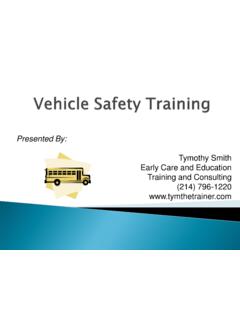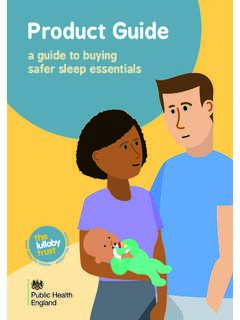Transcription of Shaken Baby Syndrome
1 Early Care and Education Training and Consulting Email: 1 Shaken Baby Syndrome / sids Training 2009 Early Care and Education Training and Consulting All Rights Reserved Children see ~ Children do. You don t stop playing because you grow old, You grow old because you stop playing.
2 Shaken Baby Syndrome Babies are fragile. Please don t shake a child Most of the time, Shaken baby Syndrome occurs when adults, frustrated and angry with children, shake them strenuously. Many well-trained, responsible people, who could never dream of hitting a child, think nothing of giving a baby a good shaking . The effects may be far more damaging then they realize. What is Shaken Baby Syndrome ? When a baby is vigorously Shaken , the head moves back and forth. The sudden whiplash motion can cause bleeding inside the head and increase pressure on the brain, causing the brain to pull apart and resulting in injury to the infant .
3 This is known as Shaken baby Syndrome , and is one of the leading forms of fatal child abuse. A baby s head and neck are susceptible to head trauma because his or her muscles are not fully developed and the brain tissue is exceptionally fragile. Head trauma is the leading cause of disability among infants and children. Baby s heads are large and heavy, making up about 25% of their total body weight. Their neck muscles are too weak to support such a disproportionately large head. Shaken Baby Syndrome occurs most frequently in infants younger than 6-months old, yet can occur up to age three.
4 Often there are no obvious outward signs of inside injury, particularly in the head or behind the eyes. In reality, shaking a baby, if only for a few seconds, can injure a baby for life. These injuries can include brain swelling and damage, cerebral palsy, mental retardation, developmental delays, blindness, hearing loss, paralysis and death . When a child is Shaken in anger or frustration, the force is multiplied five or ten times greater than it would be if the child had simply tripped or fallen.
5 How does it happen? Often, frustrated people or other people responsible for a child s care feel that shaking a baby is a harmless way to make a baby stop crying. The number one reason why a baby is Shaken is because of inconsolable crying. Almost 25% of all babies with Shaken Baby Syndrome die. It is estimated that 25-50% of parents and caretakers aren t aware of the effects of shaking a baby. What happens? When shaking occurs, the brain bounces within the skull cavity, bruising the brain tissue.
6 The brain swells, creating pressure and leading to retinal (back of the eye) bleeding. This can cause blindness. Some blood vessels feeding the brain are torn away, leading to additional brain damage or abnormalities. Blood pools within the skull, creating more pressure. Early Care and Education Training and Consulting Email: 2 Shaken Baby Syndrome / sids Training 2009 Early Care and Education Training and Consulting All Rights Reserved Children see ~ Children do.
7 You don t stop playing because you grow old, You grow old because you stop playing. Immediate Consequences Breathing may stop Seizures Limp arms and legs Excessive drooling Heart may stop death Long-Term Consequences Learning disabilities Physical disabilities Visual disabilities Speech disabilities Seizures death What can you do to prevent a tragedy? If you or someone else shakes a baby, whether accidentally or on purpose, call 911 or take the child to the emergency room immediately. Bleeding inside the brain can be treated.
8 Immediate medical attention will save your baby many future problems and possible the baby s life. Suggestions for caregivers Never throw or shake a baby Take the baby for a stroller ride Make sure the baby is fed, burped and dry Make sure clothing is not too tight Always provide support for the baby s head and neck Play music or sing to the baby Gently rock or walk the baby Give the baby a pacifier Lay the baby tummy down across your lap and rub or pat his back Ask another caregiver to take over for a while Offer a noisy toy or rattle Sit down.
9 Close your eyes and count to 20 Don t pick the baby up until you feel calm Put the baby in a front carrier close to your body and breath slowly Hug and cuddle a baby gently This information provided by the Child Abuse Prevention Center Early Care and Education Training and Consulting Email: 3 Shaken Baby Syndrome / sids Training 2009 Early Care and Education Training and Consulting All Rights Reserved Children see ~ Children do.
10 You don t stop playing because you grow old, You grow old because you stop playing. sudden infant death Syndrome What is sids ? sudden infant death Syndrome ( sids ) is the diagnosis given for the sudden death of an infant , 1-month to 1-year of age, that remains unexplained after a complete investigation. The investigation includes an autopsy, examination of the death scene, a review of the child s symptoms or illness the infant had prior to the death and any other pertinent medical history. Because most cases of sids occur wherever the infant is sleeping in a crib, sids may also be known as crib death .











